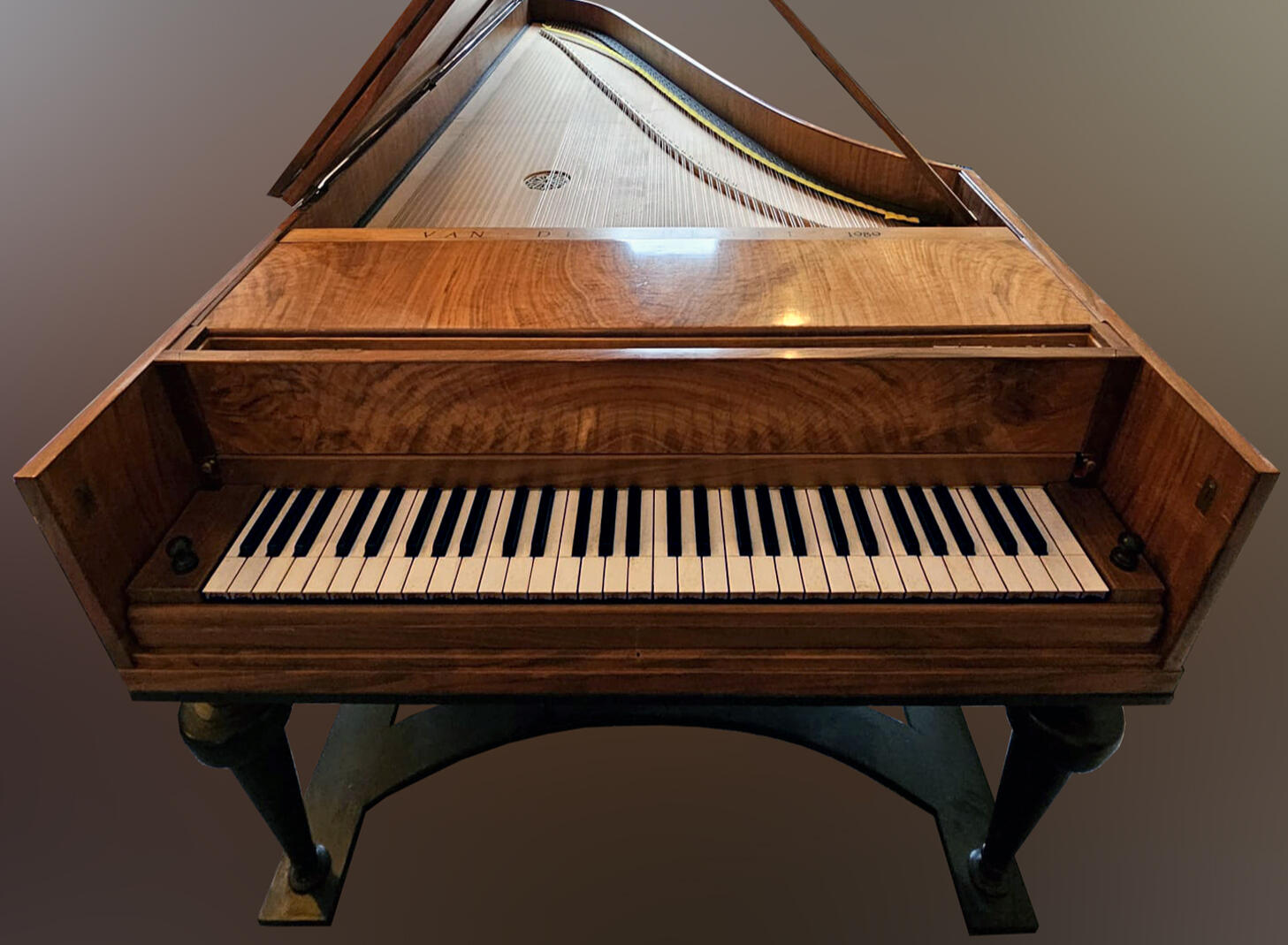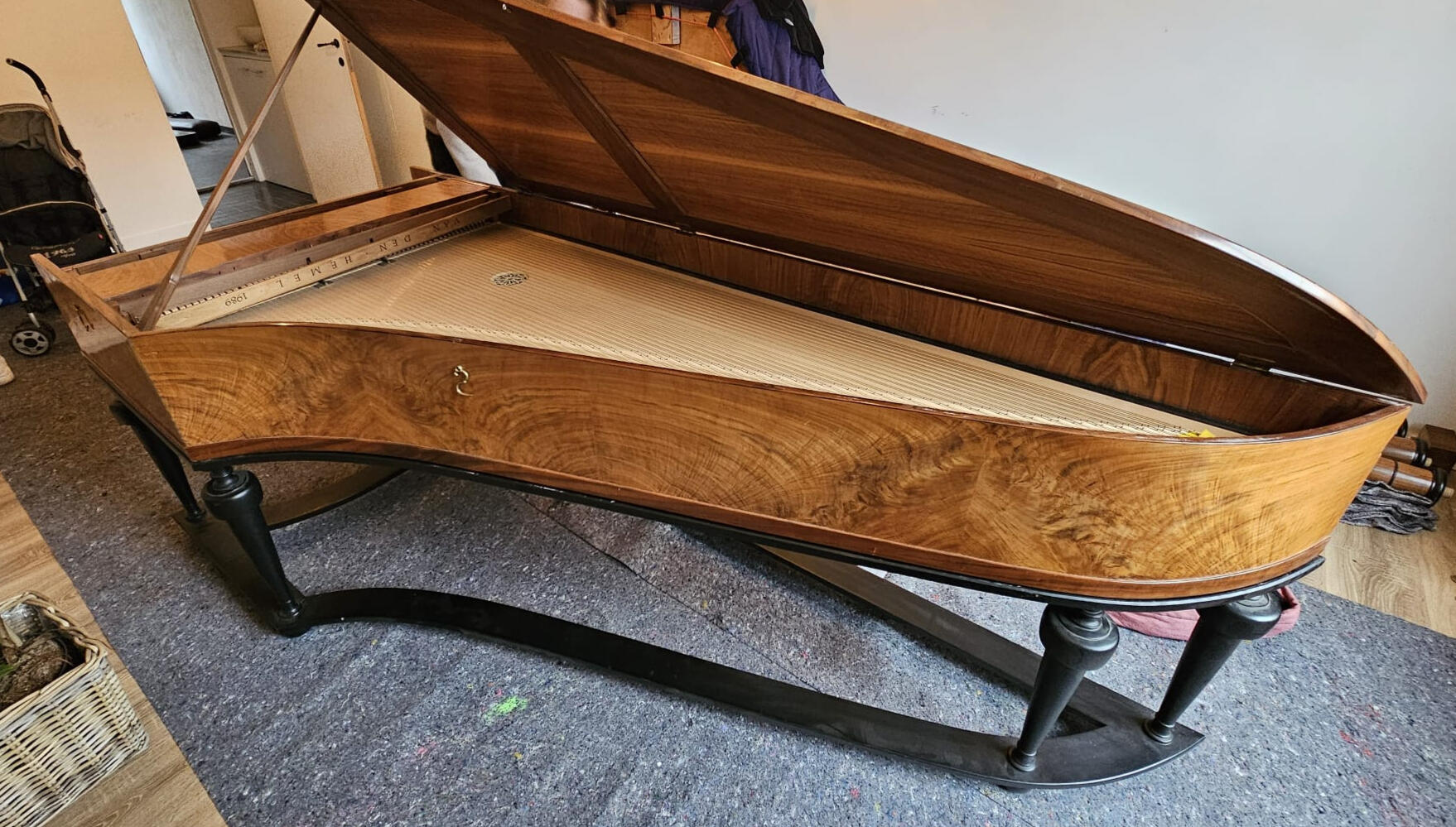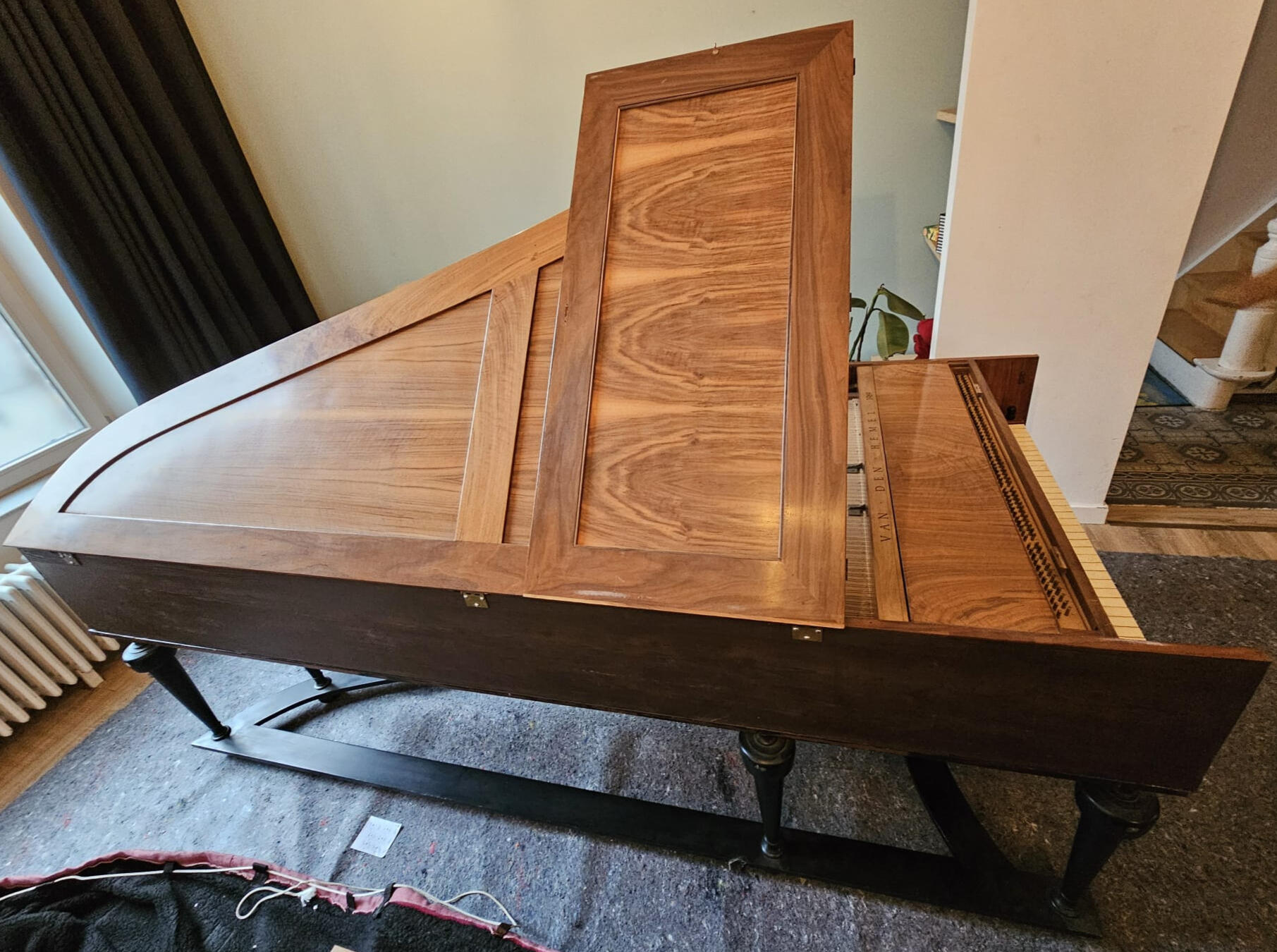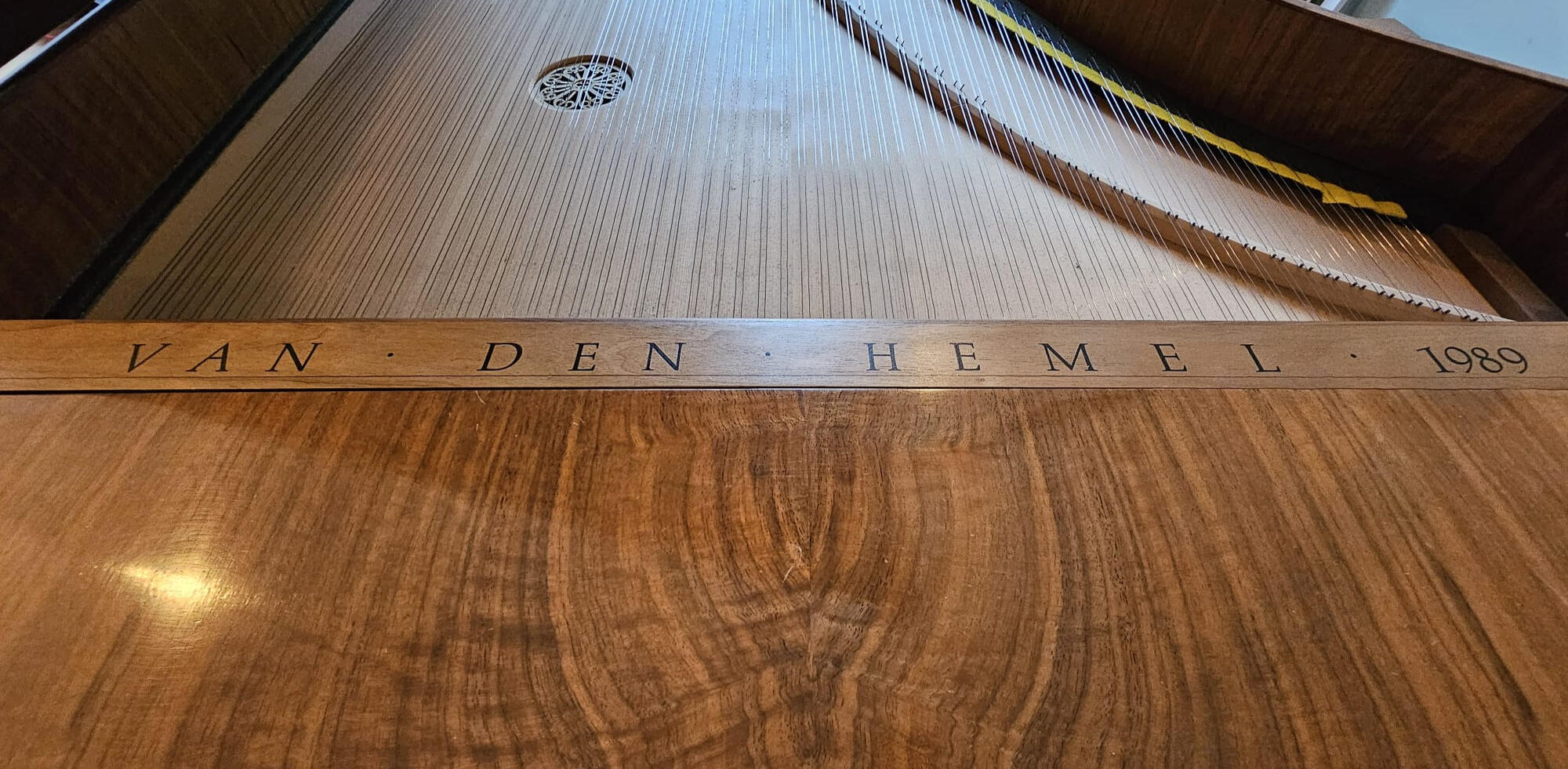Silbermann 1749
Discover a unique fortepiano built in 1989 by Jan van den Hemel, after an original 1749 pianoforte by the renowned Saxon builder Gottfried Silbermann.Silbermann, best known for his exquisite organs and keyboard instruments, played a pivotal role in the early evolution of the pianoforte.

The instrument is double strung throughout. Keyboard is FF- f"' of bone and ebony. Case in crotch walnut with inset panels. Full turned table stand. Priced at 25.000 Euro. Currently located in Ghent, Belgium, please e-mail to discuss the instrument and pricing ([email protected]).Below you can listen to a recording made with this instrument. It features Jacques Ogg playing it. "Benda: 6 Sonatas and 6 Sonatinas for Fortepiano" (More examples on Spotify can be found further down on this page).
Below are some recent images of the instrument.


If you have questions, wish to see more photos or would like to see the instrument, please get in touch with [email protected] or via the form below. The instrument can be viewed in Ghent, Belgium.
Below you can listen to more recordings by Miklos Spanyi and Jacques Ogg, where this instrument was used.
DER ERFOLGREICHE INSTRUMENTENBAUER
(written by Jan I.C. van den Hemel)Gottfried Silbermann is best known as an organ builder. He was born in Kleibobritzch (1683) near Freiberg (Saxony), and died in 1753. Little is known about his apprenticeship but he was probably apprenticed to his older brother Andreas in Strasbourg (Alsace) after a few years of “Wanderschaft.” He stayed there approximately from 1702 (?) to 1709, returning to the Freiberg area in 1710.As an organ and clavichord builder, he was highly praised by his contemporaries, but his harpsichords were also very popular.The “Orgelexaminationen” contracts and tenders etc. are an important source for us about Silbermann's doings. However, they give little information about his activities as a builder of strung keyboard instruments.SOME OF SILBERMANN'S PRECURSORS
Cristofori, whose name is associated with the first pianoforte, must have had one or more precursors or co-developers. Indeed, we can observe, that such a complicated mechanism required immersion in practice.
This required a long period of design and experimentation, use and modification; possibly too much for one lifetime.At the same time (around 1700), that Cristofori was doing his research, Pantaleon Hebenstreit was working on a salterio or cymbal, and he developed this instrument into a large and expressive instrument.He played it, among others, at the French court of Louis the 14th in 1705: the instrument then acquired the name Pantaleon.
Schröter, who also claimed the invention of the pianoforte in 1717 is said to have been inspired by it.
Marius, the inventor of the “Clavecin brisé,” based his ideas on the data of Cuisiniè of Paris, as well as those of Hebenstreit (1716). Both Schröter's and Marius' designs were far behind Cristofori's in development.THE INFLUENCE OF CRISTOFORI
The uncompromising copy Silbermann made of a Cristofori mechanism proves that he must have known a real instrument of his.The question is, however, how he came in contact with it.
Silbermann signed a contract to build the organ in the St. Sophien Church in Dresden in 1718. He completed the organ in 1720.
So he stayed in Dresden for quite some time.It is very likely, that after the renovation of the Opera at the court of Dresden by Lotti (1716-1719), a large group of Italian singers and musicians stayed there, who were in the service of the Prince-Elector of Saxony. Possibly König (court poet and translator of Maffei's article on Cristofori), provided an introduction to this milieu.
Silbermann and König knew each other well, and there are even indications that Silbermann built him a Cimbal d'Amour.It is therefore quite possible, that Silbermann encountered in these circles, sooner or later, an instrument by Cristofori taken by an Italian. It is known, that Florentine pianofortes, both those of Cristofori and those of his pupil Ferrini, ended up at the courts of Lisbon and Madrid.Five such instruments are mentioned in the inventory of Queen Maria Barbara (1758). These instruments greatly influenced the building culture of Spain and Portugal.COURT AND COUNTRY ORGAN BUILDER OF SAKSEN.
At what time Silbermann was confronted with a Cristofori, therefore, we do not know, but in connection with this the following data may be of interest; in 1723 an attestation was issued by three Dresden court virtuosos about Silbermann's work.This spoke only of clavichords, harpsichords and organs.
The Cimbal d'Amour invented in 1720 was not yet mentioned, but it was patented at Silbermann's request that very year.
As a result, Silbermann received a privilege that same year that remained in force for 15 years, and he acquired the designation “Court and country organ builder of Saxony” with this.In submitting this petition in 1723, Silbermann could have had no reason to conceal a new instrument; in other words; the pianoforte was not yet in his life?
In 1725 König's German translation of Maffei's 1709 article on Cristofori's pianoforte appeared.
Silbermann not only made the Cymbal d'Amour he invented, but also manufactured pantaleons for Hebenstreit.Until they quarreled, and Hebenstreit managed to get a royal letter prohibiting Silbermann from making pantaleons without Hebenstreit's permission.THE MUSICAL QUESTION
The translation of Maffei's article, the involvement with the pantaleon and the familiarity with Schröter's plans, may have stimulated Silbermann to also develop an instrument on which one could play loud and soft in order to meet the musical demand.Only in 1733, under the keyword Cimbal d'Amour, we find in Zedler's “Universal Lexicon” the mention, that the famous Silbermann still recently made an invention, which he calls Pianoforte, and which he presented to the Elector Frederick Augustus the year before (1732). He would thus have built his first pianoforte around the 30s.Later Adlung (1758) states, in a quotation, “that we should have from Silbermann a statement in accordance with reality, according to which model or according to which directions he undertook the manufacture of the first of these instruments in Germany. Nobody asked Mr. Silbermann for this explanation in his lifetime, and now he has been dead for some years.”
In a subsequent quote, Adlung leaves no doubt as to whether there is an invention or not;“Mr. Gottfried Silbermann is further famous for his beautiful harpsichords and clavichords, for his invention of the Cimbal d'Amour, and also for the improvement of the pianoforte. It is true that the idea for this pianoforte was first conceived and executed in Italy, but Mr. Silbermann has improved it so much that even of this instrument he is not much less than the inventor himself.”Putting everything together now, it is clear, that Silbermann started building pianofortes around 1730. Perhaps not directly, but quite soon “after” a real Florentine pianoforte.
He did not travel outside the Saxon area at that time, so he must have found the instrument there. Except between 1740-1743, during which time he worked continuously on organs, he worked on his pianoforte until 1753.Whether Gottfried Silbermann was the first to build pianofortes in “Northern Europe” is not certain.
We also know some instruments of the sons of his older brother Andreas Silbermann: Johann Gottfried (1722-1762) and Johann Heinrich (1727-1783) and Johann Andreas (1712-1783).These Strasbourg workshops seem to have had a great influence on the further development of the pianoforte, one thinks for example of J.A.Stein.
The influence of Gottfried Silbermann on pupils as far as piano construction is concerned seems to have been less, although it is claimed that Frederici worked with him for some time. About halfway through the 18th century, the new generation emerges. They develop the famous Viennese, and later the English school.ABOUT THE INSTRUMENT ITSELF
In this short time it is impossible to accurately explain Silbermann's pianoforte in terms of all its aspects.
If we compare the Florentine pianoforte with Silbermann's, we may be able to get to know him better.We currently know of three more instruments by Bartelommeo Cristofori (1720-1722-1726), and a picture by Maffei, of a mechanism such as he was then considering in 1709. Not one copy of this type of instrument, with such a mechanism, has survived. Striking are the differences among these Cristofori pianofortes, and all the more striking is the similarity of the three Silbermann instruments remaining to us. (1746-46-49), while Cristofori's instruments are quite different in terms of case, string plan, and mechanics. For example, each of his instruments contains different hammerhead types and one instrument (1720) a different tuning block system.
Silbermann's pianofortes are closest to the last Florentine instrument of 1726, especially the mechanics.Some notable differences between this 1726 Cristofori and the 1749 Silberman are: The hammer stems of the Cristofori become longer toward the bass while in Silbermann the hammer stems remain the same length. Thus, the line of attack of the hammers shows a similarity to the position of the docks in the harpsichords of both traditions.While with the Florentine pianos the damping comes off by key, with Silbermann there is a possibility, to lift the damper docks all at once. Because it is a manual system, it cannot be changed while playing. Silbermann probably made this invention with the Pantaleon still in his mind (the Pantaleon had no damping, and people therefore called this register the Pantaleon register or Pantaleon effect).
There were even pianoforts built in the 1960s and 1970s without damping!The most important consideration for this invention was undoubtedly the musical need to compensate for the poor tone inherent in the pianoforte.
Not only in terms of keyboard size both builders remain true to their tradition (Cristofori C-c''' and Silbermann FF-e'' ) but also in terms of the body of their instruments.It is clear from the foregoing that Silbermann focused primarily on the mechanical aspects of Cristofori's invention, while soundwise he continued his own Saxon tradition.
Yet this merging of two elements had its consequences; which would only be completely resolved by the next generation, although the Silbermann family in Alsace remained faithful to his concept until the 1970s.It is not impossible that both the Freiberg Silbermann and the Strasbourg Silbermann family were already looking for a simpler solution before the 1940s, and thus laid the foundation for the “prell mechanism”; the simple and effective predecessor of the “Vienna mechanism”
After these reflections, we let the instrument itself speak.Jan I.C. van den Hemel.Instrument data
Gottfried Silbermann. 1749 from the collection of the GERMANISCHES NATIONAL MUSEUM. Nurnberg.
Keyboard size FF-f'' bichord
builder Jan van den Hemel
